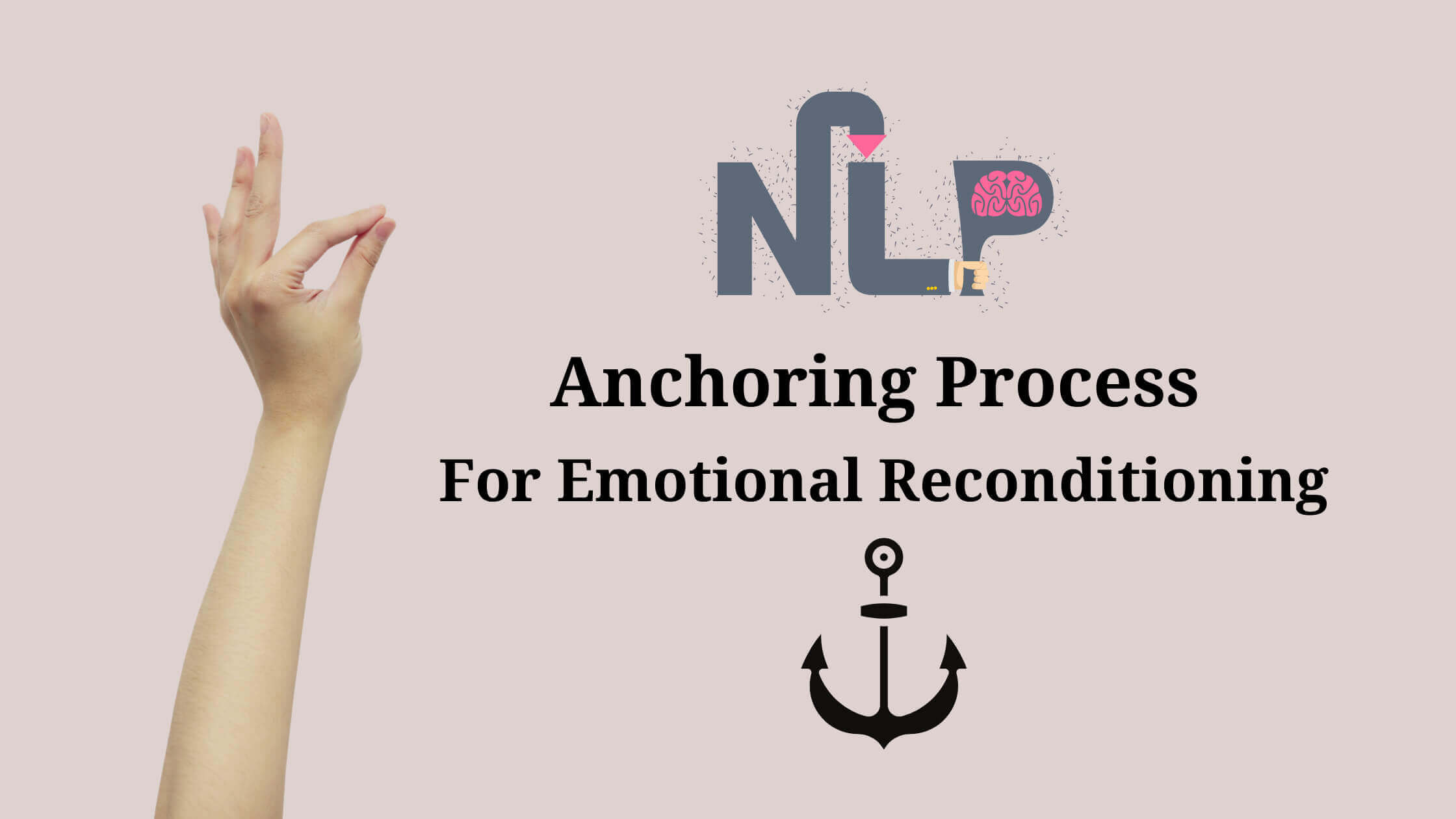While one of the most common ways of managing our emotional state is by learning to manage our thoughts, there are times that:
- The emotions are literally conditioned which means that certain people, situations or things trigger emotions instantaneously in a way that we or the client we are working with may not even be aware of the underlying thoughts or
- There are multiple triggers and doing a thought restructuring or thought reconditioning for each trigger may not be very efficient
It is in situations like these that we need an alternate way to directly and quickly work with the emotion. And that is exactly where you can use the NLP anchoring process. I am sure thinking about certain people in your life makes you very happy and then there are others the thought of whom makes you angry.
Some of you may have a lucky shirt or a lucky pen that makes you feel confident while some others may have noticed how certain places or certain actions immediately make you feel calmer or trigger fear. All of these are examples of anchors that have been created in us over the years as a result of our experiences.
Define NLP Anchors
Anchoring is a process which, on the face of it, is similar to the concept of classical conditioning in psychology and deals with associating an internal response with an external or internal trigger.
This trigger could usually be a gesture, an image or a sound.
Once a strong association is created in a person, the person experiences the internal response whenever the trigger is initiated or activated.
The good news is that it is possible to have an anchor that can help us experience certain emotions automatically and instantaneously. The bad news is that for most people these anchors are:

- External that they can’t control
- Created without awareness or choice
- After years or repetition and
- On top of that some of these anchors trigger emotions that may not be helpful in the situations where they are triggered.
So if only we had a way of being able to create anchors quickly with awareness and choice, that we could control like our actions and use in the most appropriate places or situations to experience an emotion that will be very helpful at that place or that situation. That would be great, wouldn’t that be?
This is exactly what the anchoring process is.
Applications of NLP Anchoring Process
In simple words, the process can help you experience emotions that you choose to experience when you choose to experience them. You can use the process to anchor the feeling of:
- Happiness or joy and experience them with people or situations you want to or
- Excitement or motivation or confidence and experience them when doing certain things that need to be done or
- Even disgust and connect that feeling to smoking or tea or something else that you want to quit.
Who can benefit from Anchors?
- Individuals access appropriate emotions which can help them achieve their outcomes and
- Coaches, therapists & trainers in helping their clients and participants achieve their outcomes. Because of its simplicity, it can be combined with almost any form of therapy and training easily & effectively.
The Five Keys to NLP Anchoring – ITURN:
- Intensity of the Experience (I):
Before installing an anchor make the experience as intense & powerful as possible. - Timing of the Anchor (T):
Install the anchor at a time when the desired mental state is experienced by the person at its peak. - Uniqueness of the Anchor (U):
In most cases the anchor should be unique i.e. the gesture or the sound or the visual is not connected to another mental state already. - Replication of the Stimulus (R):
The anchor should be such that the person can - Number of times (N):
Repeat this process number of times to make the anchor stronger & more effective.
Step by Step Guide to Use NLP Anchoring with clients for reconditioning emotional response
To simplify the process of creating and using anchors, we will divide the process into 3 steps.
Step 1: Collecting information

Before you start the anchoring process, it is useful to have the following information from the client:
- Emotion that they will like to anchor. For example confidence, calmness, peace, happiness, disgust and so on….
- Specific past experience where they have experienced the emotion at its peak. In the absence of a past experience, you can also use a detailed future imagination.
- What action would the client like to anchor this emotion to. In this post we will use the action of pressing the right index finger with the thumb as the anchor. When selecting the action just remember that the action should be unique and is not already used as an anchor for another emotion.
Step 2: Anchor the emotion
Begin by asking the client to close their eyes and observe their breath 3 times.
Then ask the client to go back in time in their mind to the time or the event that they had described to you, the event where they experienced the positive emotion that would like to anchor at its peak.
As the client remembers or recalls that experience, suggest that the experience is becoming more vivid, more real, and more intense and ask the client to say yes once the feeling is at its peak.
Once the client says yes, check that the client is associated i.e. experiencing the memory in first person and then ask the client to bring the index finger and thumb of the right hand together and press it tightly. Suggest that the feeling is becoming stronger.
After a couple of seconds suggest that everytime they bring the finger and thumb closer and press it tightly they will experience this emotion at its peak. Add an ideo-motor response like breath becoming deeper or the finger of left hand lifting up unconsciously to indicate that the association has been made.
Give the client a couple of mins and then ask the client to let all the images and feelings settle down and then ask them to rub their hands, bring them closer to their eyes, feel the warmth in their eyes and then come back to the present and open their eyes wide awake.
Request the client to have a sip of water. After the client opens their eyes, give them some time to break the state. Talk about other things for a couple of mins.
Step 3: Test the Anchor
To test the anchor, ask the client to close their eyes once again. Next ask them to bring the index finger and the thumb closer and press it tightly, exactly the way they were doing it at the time of creating the anchor. As the client does this, ask them to verbalise the emotion they are feeling.
If the anchor was created correctly in the previous step, the client would immediately feel the anchored emotion. Once the client confirms the feeling, you can gently ask the client to come back to the present. Repeat the process we used in the previous step to waking the client.
If you would like to learn about advanced applications of anchoring in coaching and therapy or understand the conceptual background of how and why this process works and what to do when it doesn’t, then I would recommend that you can checkout either the Cognitive Hypnotic Coaching or the Cognitive Hypnotic Psychotherapy Diploma.

